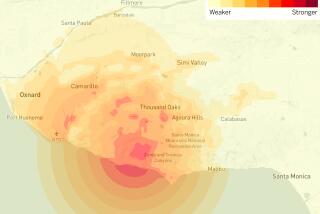California’s funds for mapping earthquake faults running out
California is about to run out of money for mapping earthquake faults, leaving many communities across the state with limited information about the seismic risks of new development.
The California Geological Survey has about 300 more fault maps left to complete, including some covering highly populated areas like the Westside of Los Angeles, the San Diego Bay area, and the San Gabriel Valley. But officials say the budget for mapping will run out once the state completes work on the Hollywood fault early next year.
Seismic experts say completing the mapping is crucial because the state’s strict earthquake building regulations only apply to faults that have been zoned by the California Geological Survey. The regulations prohibit building on top of faults and require extensive seismic testing for any structure built within about 500 feet of a fault.
The slow pace of the state’s mapping has come under new scrutiny in recent months because of several large projects in Los Angeles that were approved on or near the Hollywood fault.
On Monday, state Sen. Ted W. Lieu (D-Torrance) called on the state Legislature to boost funding so the mapping can continue.
California aggressively mapped faults between the 1970s through the early 1990s. Then, a series of budget cuts slowed the effort dramatically. No new fault zoning occurred between 2004 and 2011. The California Geological Survey restarted the effort again using its existing budget, but that money will dry up next year, said State Geologist John Parrish.
At one time, the state had six people focused on fault mapping. That will drop to one person by next year, and no staffers are budgeted after June.
Lieu said that the state’s budget situation has improved significantly in the last few years and fully funding fault mapping should be done immediately.
“It boggles my mind,” Lieu said in an interview. “Every day across California, local planning departments are making decisions, and we need to make sure that no future buildings are going to be built on fault lines simply because a map wasn’t updated.”
His remarks come after The Times reported Monday that at least 18 buildings were approved for construction on or near the Hollywood and Santa Monica faults over the last decade without the rigorous studies that would have been required had the state zoned those faults. They include apartments, condos, an office building and a grocery store. Both faults are well-known and capable of producing disastrous earthquakes.
“Most people are completely unaware that you have a whole bunch of buildings being built along earthquake fault lines. Because they’re not supposed to be built there,” Lieu added.
The state is now placing a zone around the Hollywood fault, an effort expected to be completed in 2014. But there are no funds to draw zones for the neighborhoods surrounding the Santa Monica fault and other faults on the state’s priority list in the San Francisco Bay Area, San Diego, Riverside and San Bernardino counties, and the Napa and Lake Tahoe areas.
Updates are needed for other faults, like the Whittier fault near Yorba Linda.
California lawmakers banned new buildings on top of earthquake faults after homes sitting astride the fissures were ripped apart in the 1971 Sylmar earthquake, said U.S. Geological Survey seismologist Lucy Jones. One side of the San Fernando fault shifted from the other by as much as eight feet, and about 80% of the buildings along the fault suffered moderate to severe damage.
To enforce the law, the state drew zones around the neighborhoods surrounding the faults, generally 500 feet on each side. Officials said that before new construction can begin, an investigation — such as digging a trench — must be done to make sure the fault is absent underneath the building site. Construction is only prohibited on land directly on top of the fault rupture line and generally within 50 feet of it.
“Without funding the California Geological Survey to complete the mapping, you can’t follow the law,” Jones said.
Buildings on top of earthquake faults are in “very dangerous locations,” said Parrish, the state geologist. “We’re trying to put the information out there so people can make their decisions.”
Scientists rushed to better understand faults after a previously unknown fault caused the devastating 1994 Northridge earthquake.
That’s why new maps of the Hollywood and Santa Monica faults were drawn by scientists in the 1990s. But that information hasn’t yet been converted into the state’s quake fault zone maps.
“What we’re talking about is going from the research the academics did … and turning that into information that allows you to follow the law,” Jones said.
Placing zones around faults provides the public with more information: Potential home buyers must be told about the fault zone, and developers who discover faults in state zones must report their discoveries to the state.
But if a fault zone doesn’t exist, there is no requirement to share that information, state officials said.
The Times in October first reported how budget cuts dramatically slowed the mapping of fault zones. More than 500 maps were drawn in the first two decades of the law, but only about 20 have been drawn in the following two decades.
The state geologist’s budget has dropped from $9.1 million in 2001 to $2.9 million for the current fiscal year.
Gov. Jerry Brown was unavailable for comment. A spokesman said his office generally does not discuss details of the budget before releasing it in January.
More to Read
Start your day right
Sign up for Essential California for news, features and recommendations from the L.A. Times and beyond in your inbox six days a week.
You may occasionally receive promotional content from the Los Angeles Times.









